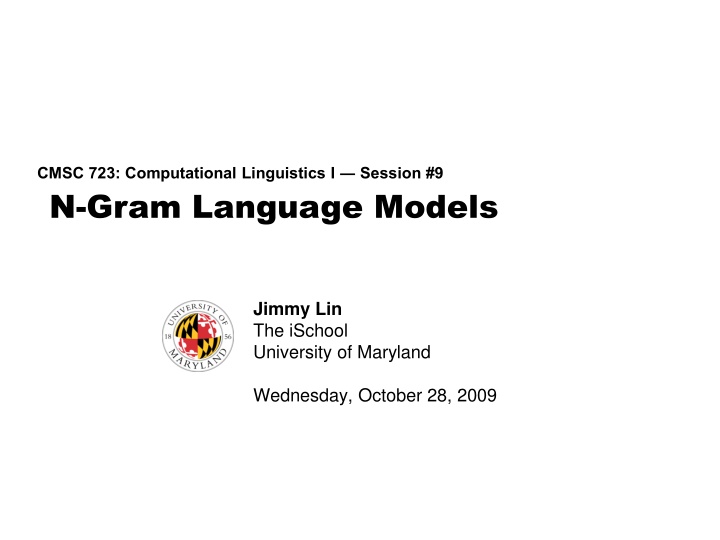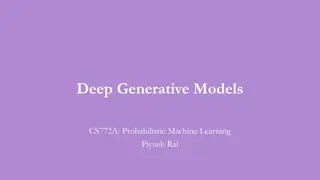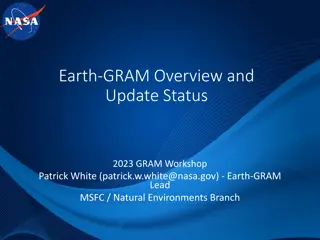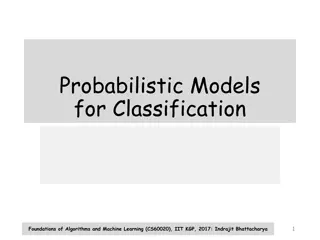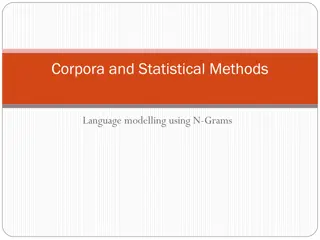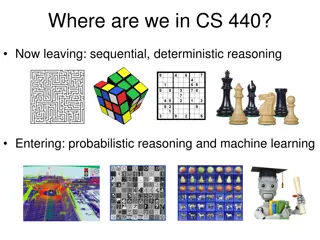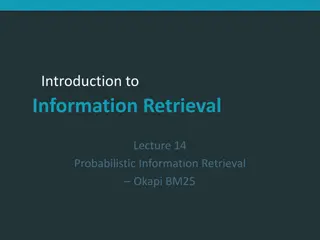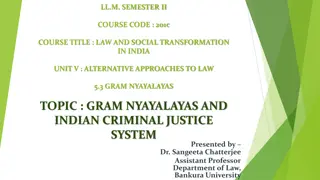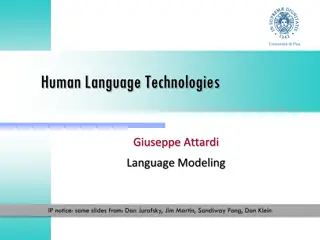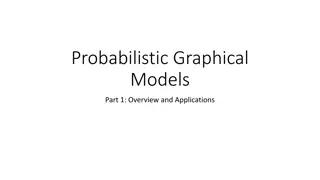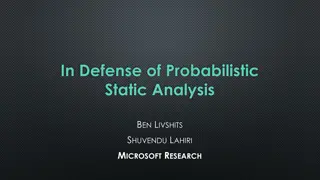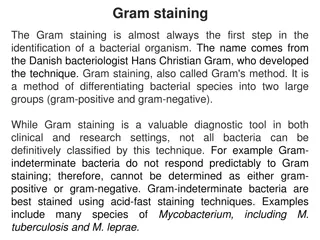N-Gram Language Models and Probabilistic Computations
Delve into the realm of N-gram language models, their applications in computational linguistics, and the computational complexities in assigning probabilities to sequences of tokens. Explore the evolution from unigrams to trigrams, the Markov assumption for approximating probabilities, and the practical challenges in computing probabilities accurately.
Download Presentation

Please find below an Image/Link to download the presentation.
The content on the website is provided AS IS for your information and personal use only. It may not be sold, licensed, or shared on other websites without obtaining consent from the author.If you encounter any issues during the download, it is possible that the publisher has removed the file from their server.
You are allowed to download the files provided on this website for personal or commercial use, subject to the condition that they are used lawfully. All files are the property of their respective owners.
The content on the website is provided AS IS for your information and personal use only. It may not be sold, licensed, or shared on other websites without obtaining consent from the author.
E N D
Presentation Transcript
CMSC 723: Computational Linguistics I Session #9 N-Gram Language Models Jimmy Lin The iSchool University of Maryland Wednesday, October 28, 2009
N-Gram Language Models What? LMs assign probabilities to sequences of tokens Why? Statistical machine translation Speech recognition Handwriting recognition Predictive text input How? Based on previous word histories n-gram = consecutive sequences of tokens
Huh? Noam Chomsky Fred Jelinek But it must be recognized that the notion probability of a sentence is an entirely useless one, under any known interpretation of this term. (1969, p. 57) Anytime a linguist leaves the group the recognition rate goes up. (1988) Every time I fire a linguist
N-Gram Language Models N=1 (unigrams) This is a sentence Unigrams: This, is, a, sentence Sentence of length s, how many unigrams?
N-Gram Language Models N=2 (bigrams) This is a sentence Bigrams: This is, is a, a sentence Sentence of length s, how many bigrams?
N-Gram Language Models N=3 (trigrams) This is a sentence Trigrams: This is a, is a sentence Sentence of length s, how many trigrams?
Computing Probabilities [chain rule] Is this practical? No! Can t keep track of all possible histories of all words!
Approximating Probabilities Basic idea: limit history to fixed number of words N (Markov Assumption) N=1: Unigram Language Model Relation to HMMs?
Approximating Probabilities Basic idea: limit history to fixed number of words N (Markov Assumption) N=2: Bigram Language Model Relation to HMMs?
Approximating Probabilities Basic idea: limit history to fixed number of words N (Markov Assumption) N=3: Trigram Language Model Relation to HMMs?
Building N-Gram Language Models Use existing sentences to compute n-gram probability estimates (training) Terminology: N = total number of words in training data (tokens) V = vocabulary size or number of unique words (types) C(w1,...,wk) = frequency of n-gram w1, ..., wk in training data P(w1, ..., wk) = probability estimate for n-gram w1 ... wk P(wk|w1, ..., wk-1) = conditional probability of producing wk given the history w1, ... wk-1 What s the vocabulary size?
Vocabulary Size: Heaps Law M = M is vocabulary size T is collection size (number of documents) k and b are constants b kT Typically, k is between 30 and 100, b is between 0.4 and 0.6 Heaps Law: linear in log-log space Vocabulary size grows unbounded!
Heaps Law for RCV1 k = 44 b = 0.49 First 1,000,020 terms: Predicted = 38,323 Actual = 38,365 Reuters-RCV1 collection: 806,791 newswire documents (Aug 20, 1996-August 19, 1997) Manning, Raghavan, Sch tze, Introduction to Information Retrieval (2008)
Building N-Gram Models Start with what s easiest! Compute maximum likelihood estimates for individual n-gram probabilities Unigram: Why not just substitute P(wi) ? Bigram: Uses relative frequencies as estimates Maximizes the likelihood of the data given the model P(D|M)
Example: Bigram Language Model <s> <s> <s> </s> </s> I am Sam Sam I am I do not like green eggs and ham </s> Training Corpus P( I | <s> ) = 2/3 = 0.67 P( am | I ) = 2/3 = 0.67 P( </s> | Sam )= 1/2 = 0.50 ... P( Sam | <s> ) = 1/3 = 0.33 P( do | I ) = 1/3 = 0.33 P( Sam | am) = 1/2 = 0.50 Bigram Probability Estimates Note: We don t ever cross sentence boundaries
Building N-Gram Models Start with what s easiest! Compute maximum likelihood estimates for individual n-gram probabilities Unigram: Let s revisit this issue Why not just substitute P(wi) ? Bigram: Uses relative frequencies as estimates Maximizes the likelihood of the data given the model P(D|M)
More Context, More Work Larger N = more context Lexical co-occurrences Local syntactic relations More context is better? Larger N = more complex model For example, assume a vocabulary of 100,000 How many parameters for unigram LM? Bigram? Trigram? Larger N has another more serious and familiar problem!
Data Sparsity P( I | <s> ) = 2/3 = 0.67 P( am | I ) = 2/3 = 0.67 P( </s> | Sam )= 1/2 = 0.50 ... P( Sam | <s> ) = 1/3 = 0.33 P( do | I ) = 1/3 = 0.33 P( Sam | am) = 1/2 = 0.50 Bigram Probability Estimates P(I like ham) = P( I | <s> ) P( like | I ) P( ham | like ) P( </s> | ham ) = 0 Why? Why is this bad?
Data Sparsity Serious problem in language modeling! Becomes more severe as N increases What s the tradeoff? Solution 1: Use larger training corpora Can t always work... Blame Zipf s Law (Looong tail) Solution 2: Assign non-zero probability to unseen n-grams Known as smoothing
Smoothing Zeros are bad for any statistical estimator Need better estimators because MLEs give us a lot of zeros A distribution without zeros is smoother The Robin Hood Philosophy: Take from the rich (seen n- grams) and give to the poor (unseen n-grams) And thus also called discounting Critical: make sure you still have a valid probability distribution! Language modeling: theory vs. practice
Laplaces Law Simplest and oldest smoothing technique Just add 1 to all n-gram counts including the unseen ones So, what do the revised estimates look like?
Laplaces Law: Probabilities Unigrams Bigrams Careful, don t confuse the N s! What if we don t know V?
Laplaces Law: Frequencies Expected Frequency Estimates Relative Discount
Laplaces Law Bayesian estimator with uniform priors Moves too much mass over to unseen n-grams What if we added a fraction of 1 instead?
Lidstones Law of Succession Add 0 < < 1 to each count instead The smaller is, the lower the mass moved to the unseen n-grams (0=no smoothing) The case of = 0.5 is known as Jeffery-Perks Law or Expected Likelihood Estimation How to find the right value of ?
Good-Turing Estimator Intuition: Use n-grams seen once to estimate n-grams never seen and so on Compute Nr (frequency of frequency r) N0 is the number of items with count 0 N1 is the number of items with count 1
Good-Turing Estimator For each r, compute an expected frequency estimate (smoothed count) Replace MLE counts of seen bigrams with the expected frequency estimates and use those for probabilities
Good-Turing Estimator What about an unseen bigram? Do we know N0? Can we compute it for bigrams?
Good-Turing Estimator: Example r 1 2 3 4 5 6 Nr (14585)2 - 199252 N0 = Cunseen = Punseen = Note: Assumes mass is uniformly distributed 138741 25413 10531 5997 3565 ... N1 / N0 = 0.00065 N1/( N0N ) = 1.06 x 10-9 V = 14585 Seen bigrams =199252 C(person she) = 2 C(person) = 223 CGT(person she) = (2+1)(10531/25413) = 1.243 P(she|person) =CGT(person she)/223 = 0.0056
Good-Turing Estimator For each r, compute an expected frequency estimate (smoothed count) Replace MLE counts of seen bigrams with the expected frequency estimates and use those for probabilities What if wiisn t observed?
Good-Turing Estimator Can t replace all MLE counts What about rmax? Nr+1 = 0 for r = rmax Solution 1: Only replace counts for r < k (~10) Solution 2: Fit a curve S through the observed (r, Nr) values and use S(r) instead For both solutions, remember to do what? Bottom line: the Good-Turing estimator is not used by itself but in combination with other techniques
Combining Estimators Better models come from: Combining n-gram probability estimates from different models Leveraging different sources of information for prediction Three major combination techniques: Simple Linear Interpolation of MLEs Katz Backoff Kneser-Ney Smoothing
Linear MLE Interpolation Mix a trigram model with bigram and unigram models to offset sparsity Mix = Weighted Linear Combination
Linear MLE Interpolation i are estimated on some held-out data set (not training, not test) Estimation is usually done via an EM variant or other numerical algorithms (e.g. Powell)
Backoff Models Consult different models in order depending on specificity (instead of all at the same time) The most detailed model for current context first and, if that doesn t work, back off to a lower model Continue backing off until you reach a model that has some counts
Backoff Models Important: need to incorporate discounting as an integral part of the algorithm Why? MLE estimates are well-formed But, if we back off to a lower order model without taking something from the higher order MLEs, we are adding extra mass! Katz backoff Starting point: GT estimator assumes uniform distribution over unseen events can we do better? Use lower order models!
Katz Backoff Given a trigram x y z
Katz Backoff (from textbook) Given a trigram x y z Typo?
Katz Backoff Why use PGT and not PMLE directly ? If we use PMLE then we are adding extra probability mass when backing off! Another way: Can t save any probability mass for lower order models without discounting Why the s? To ensure that total mass from all lower order models sums exactly to what we got from the discounting
Kneser-Ney Smoothing Observation: Average Good-Turing discount for r 3 is largely constant over r So, why not simply subtract a fixed discount D( 1) from non-zero counts? Absolute Discounting: discounted bigram model, back off to MLE unigram model Kneser-Ney: Interpolate discounted model with a special continuation unigram model
Kneser-Ney Smoothing Intuition Lower order model important only when higher order model is sparse Should be optimized to perform in such situations Example C(Los Angeles) = C(Angeles) = M; M is very large Angeles always and only occurs after Los Unigram MLE for Angeles will be high and a normal backoff algorithm will likely pick it in any context It shouldn t, because Angeles occurs with only a single context in the entire training data
Kneser-Ney Smoothing Kneser-Ney: Interpolate discounted model with a special continuation unigram model Based on appearance of unigrams in different contexts Excellent performance, state of the art = number of different contexts wihas appeared in Why interpolation, not backoff?
Explicitly Modeling OOV Fix vocabulary at some reasonable number of words During training: Consider any words that don t occur in this list as unknown or out of vocabulary (OOV) words Replace all OOVs with the special word <UNK> Treat <UNK> as any other word and count and estimate probabilities During testing: Replace unknown words with <UNK> and use LM Test set characterized by OOV rate (percentage of OOVs)
Evaluating Language Models Information theoretic criteria used Most common: Perplexity assigned by the trained LM to a test set Perplexity: How surprised are you on average by what comes next ? If the LM is good at knowing what comes next in a sentence Low perplexity (lower is better) Relation to weighted average branching factor
Computing Perplexity Given testset W with words w1, ...,wN Treat entire test set as one word sequence Perplexity is defined as the probability of the entire test set normalized by the number of words Using the probability chain rule and (say) a bigram LM, we can write this as A lot easer to do with log probs!
Practical Evaluation Use <s> and </s> both in probability computation Count </s> but not <s> in N Typical range of perplexities on English text is 50-1000 Closed vocabulary testing yields much lower perplexities Testing across genres yields higher perplexities Can only compare perplexities if the LMs use the same vocabulary Order Unigram Bigram Trigram PP 962 170 109 Training: N=38 million, V~20000, open vocabulary, Katz backoff where applicable Test: 1.5 million words, same genre as training
Typical State of the Art LMs Training N = 10 billion words, V = 300k words 4-gram model with Kneser-Ney smoothing Testing 25 million words, OOV rate 3.8% Perplexity ~50
Take-Away Messages LMs assign probabilities to sequences of tokens N-gram language models: consider only limited histories Data sparsity is an issue: smoothing to the rescue Variations on a theme: different techniques for redistributing probability mass Important: make sure you still have a valid probability distribution!
